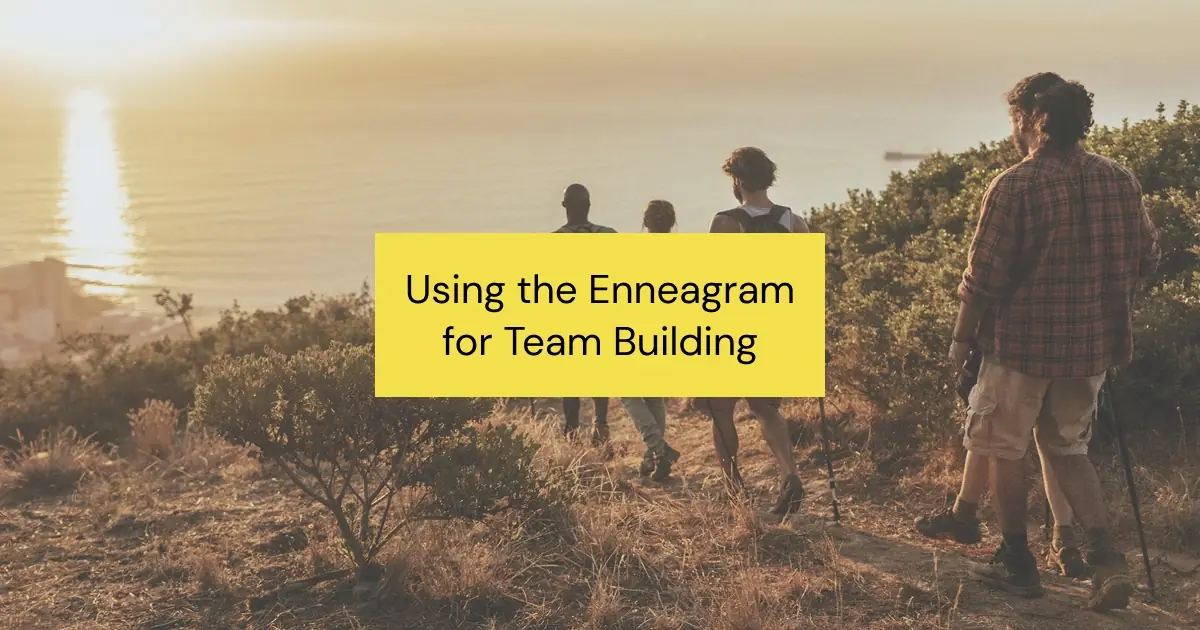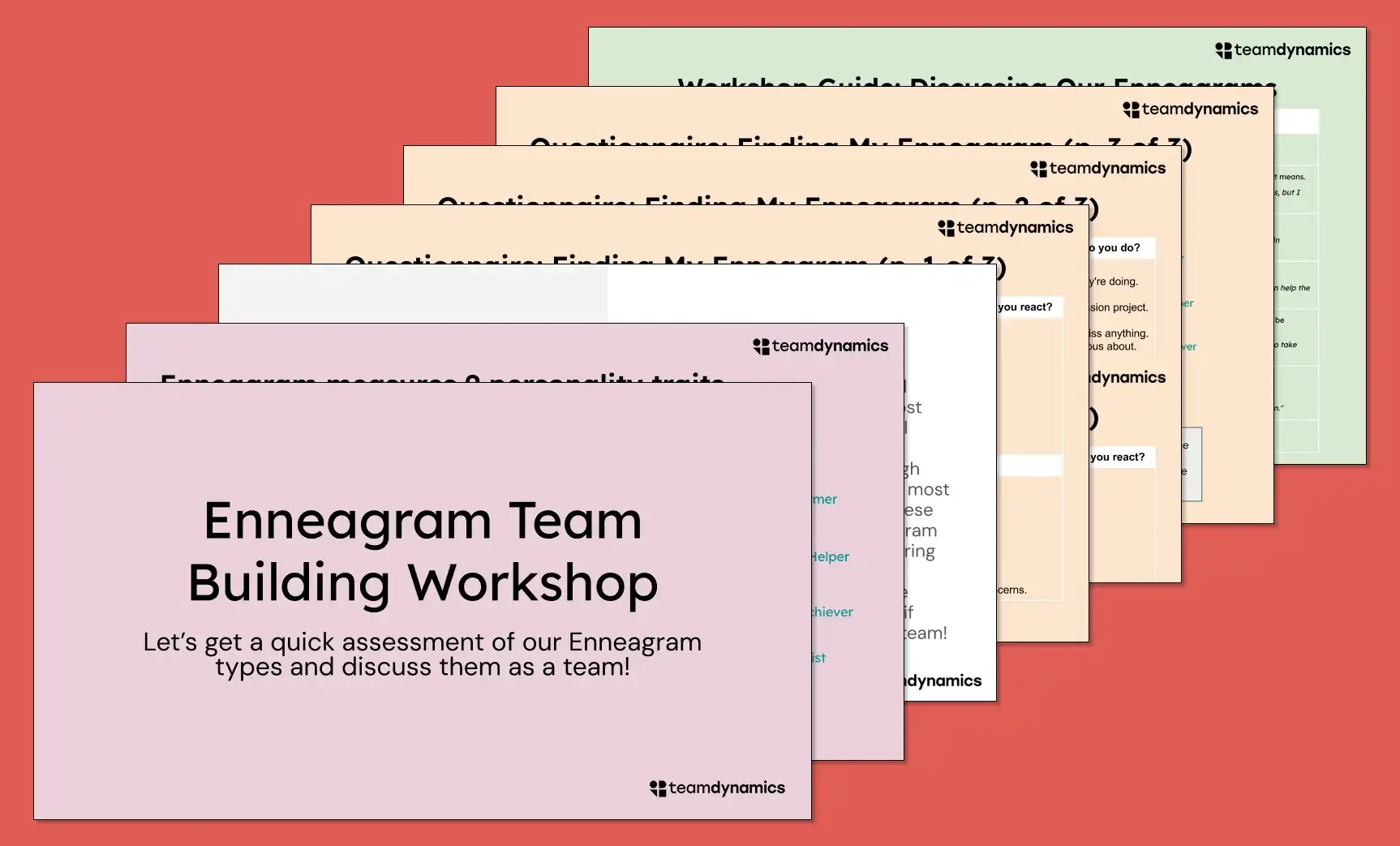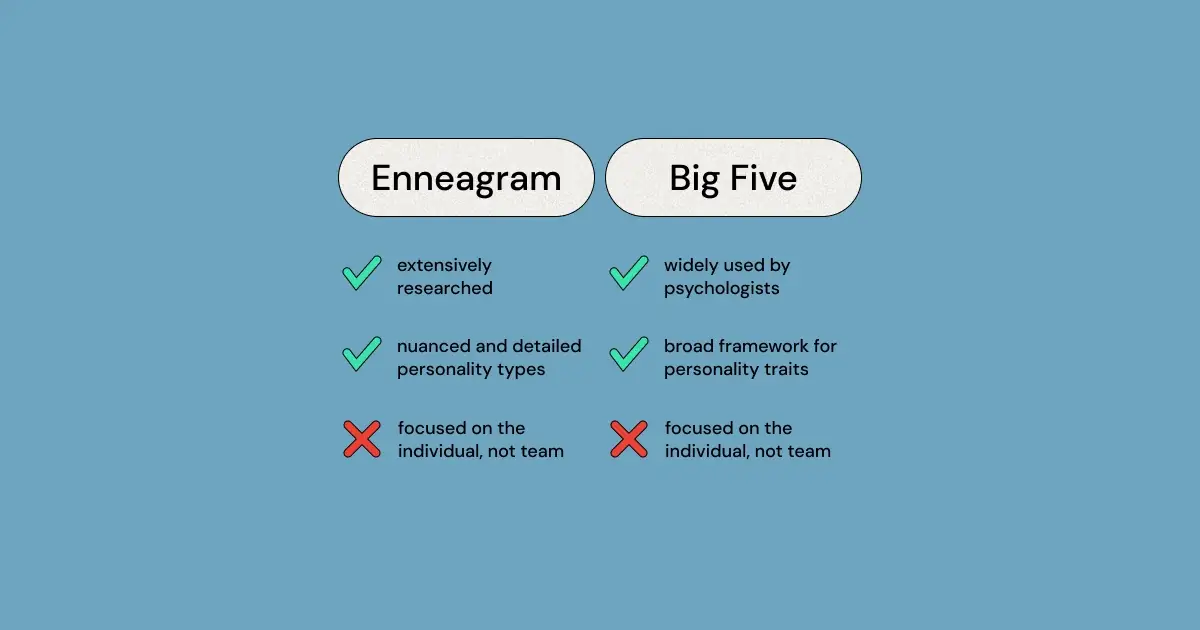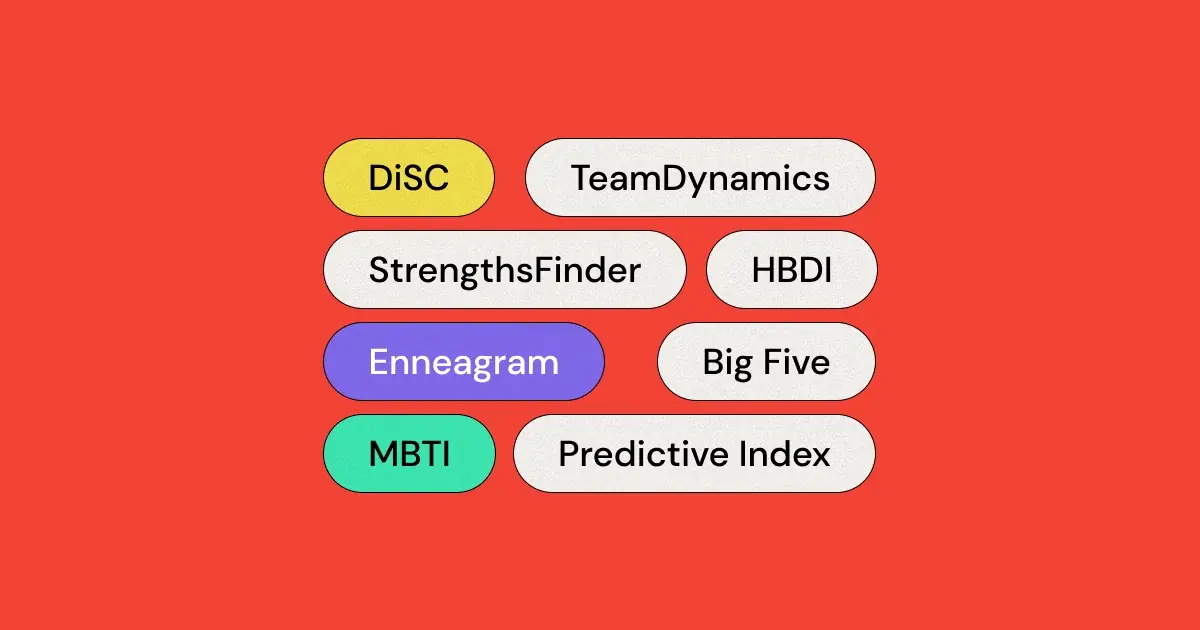Welcome to the dynamic world of team building, where understanding each other isn’t just helpful—it’s essential for success. Imagine a scenario where a tech startup team navigates challenges seamlessly, a marketing team creates campaigns that resonate deeply, or a consulting team collaborates flawlessly on complex projects. What's their secret? It might just be a tool called the Enneagram personality test.
In our fast-paced professional world, the key to a high-performing team often lies beyond skills and experience—it’s in the deep understanding of each team member's personality. That's where the Enneagram comes into play. Unlike traditional personality assessments, the Enneagram offers a nuanced and dynamic insight into team members' motivations, fears, and strengths.
So, why should you, a professional in a team setting, pay attention to this? Because the Enneagram can be your roadmap to unlocking the full potential of your team. Whether you're in a bustling tech startup, a creative marketing squad, or a strategic consulting group, the Enneagram could be the key to transforming your team's dynamics and boosting your collective success.
Looking for something other than the Enneagram? Here are the top 5 alternatives to Enneagram!
In this blog post, we're diving deep into the Enneagram world. We'll explore what it is, why it’s unique, and most importantly, how it can revolutionize your team’s way of working together. Plus, we'll provide practical tips on implementing the Enneagram in your team, navigating potential challenges, and making the most out of this ancient yet incredibly relevant tool.
Stay tuned as we unfold the secrets of the Enneagram and how it can elevate your team to new heights of collaboration and efficiency.
What is the Enneagram?
Step into the fascinating world of the Enneagram, a tool that’s not just another personality test – it's a window into the complex tapestry of human nature. In today’s collaborative environments, like a fast-paced tech startup, an innovative marketing team, or a strategic consulting firm, understanding the Enneagram could be the key to unlocking a treasure trove of team dynamics insights.
A Journey Through Time and Psychology
The Enneagram has ancient roots, with a history that spans centuries. It's more than just a test; it's a profound psychological framework that maps out nine distinct personality types. Each of these types is not just a label but a rich, descriptive narrative of different motivations, fears, desires, and strengths that drive human behavior.
The Nine Faces of the Enneagram
Let's meet the cast of the Enneagram:
The Reformer (Type 1): Principled and perfectionist
Reformers are often the perfectionists at work. They strive for high standards and are typically detail-oriented, organized, and ethical. They are driven by a sense of right and wrong and work diligently to improve processes and systems. However, they can be overly critical and may struggle with flexibility.
The Helper (Type 2): Caring and people-pleasing
Helpers are the supportive and caring individuals in the office. They are great at understanding colleagues' needs and often go out of their way to assist others. While they excel in team cohesion and morale boosting, they may have difficulty setting boundaries and can become overly involved in others' issues.
The Achiever (Type 3): Success-oriented and driven
Achievers are goal-oriented and success-driven. They are usually very competent, efficient, and highly motivated by achievement and recognition. They excel in roles that reward performance but may become overly focused on status and appearance, sometimes neglecting deeper personal or ethical considerations.
The Individualist (Type 4): Sensitive and withdrawn
Individualists bring creativity and a unique perspective to their work. They are often in touch with their emotions and can be very empathetic. They excel in roles that require creativity and individual expression but may struggle with feeling misunderstood or out of place in more structured environments.
The Investigator (Type 5): Intense and cerebral
Investigators are the analytical and insightful ones, often very perceptive and innovative. They excel in roles that require deep thinking and problem-solving. However, they may become detached or overly private, preferring to work alone, which can sometimes hinder teamwork.
The Loyalist (Type 6): Committed and security-oriented
Loyalists are responsible, trustworthy, and value security and stability. They are excellent at risk assessment and foreseeing problems. While they are committed and hard-working, their fear of uncertainty can lead them to be overly cautious or indecisive.
The Enthusiast (Type 7): Busy and fun-loving
Enthusiasts are the energetic, optimistic, and versatile members of the team. They are good at multi-tasking and bring a positive spirit to their work. Their enthusiasm is infectious, although they can become distracted and may struggle to focus on mundane or detailed tasks.
The Challenger (Type 8): Powerful and dominating
Challengers are confident, assertive, and decisive. They excel in leadership roles and are not afraid to tackle difficult issues. They bring a sense of control and strength to teams but may struggle with being overly confrontational or failing to recognize others’ viewpoints.
The Peacemaker (Type 9): Easygoing and agreeable
Peacemakers are easygoing, reassuring, and agreeable. They are great at mediating conflicts and bringing a sense of calm to the workplace. They excel in roles that require diplomacy and consensus-building. However, their desire to avoid conflict can sometimes lead them to be complacent or indecisive.
Each of these types brings a unique set of skills, perspectives, and approaches to a team setting. Understanding these types in the context of a professional environment can be transformative.
Why the Enneagram Stands Out
Unlike other personality tests that might offer a static view of an individual, the Enneagram is dynamic. It acknowledges that people can exhibit different traits in different situations, especially under stress or growth conditions. This fluidity makes the Enneagram a powerful tool for understanding team members in the ever-changing landscape of professional challenges.
In essence, the Enneagram is more than a test – it’s a comprehensive guide to understanding the diverse personalities that make up a team. It’s a tool that provides deeper insight into what makes each team member tick, paving the way for enhanced collaboration, communication, and ultimately, success in any team-oriented environment.
Benefits of Using the Enneagram in Team Building
In a world where team dynamics can make or break a project, understanding the individual personalities within your team is not just beneficial; it's crucial. This is where the Enneagram shines, offering a kaleidoscope of insights into the human psyche. For professionals in any setting, from the bustling atmosphere of a tech startup to the strategic halls of a consulting firm, the Enneagram can be a transformative tool. Let's explore the benefits of using this intricate yet practical system in team building.
Improved Team Communication and Understanding
Each Enneagram type communicates differently. By understanding these styles, teams can tailor their interactions to be more effective and empathetic. For instance, a Type 3 Achiever's directness can be balanced with the Type 9 Peacemaker's diplomacy, fostering a communication style that is both assertive and considerate.
Enhanced Conflict Resolution Strategies
Conflicts often arise from misunderstandings or differing perspectives. The Enneagram helps in identifying the root causes of conflicts based on personality types. A Type 6 Loyalist’s security-driven concerns can be effectively addressed by understanding their perspective, leading to more productive and less emotionally charged conflict resolutions.
Increased Team Cohesion and Collaboration
Understanding each other's strengths and weaknesses allows teams to work more cohesively. A Type 1 Reformer’s attention to detail complements a Type 7 Enthusiast’s innovative ideas. This mutual understanding can transform a group of individuals into a well-synchronized team, where each member feels valued and understood.
{{inline-cta}}
Real-World Success Stories
Consider the story of a tech startup that leveraged the Enneagram to streamline their development process. By aligning tasks with their team members' Enneagram types, they saw a significant increase in productivity and a decrease in turnover. Or, the marketing team that used Enneagram insights to tailor their campaigns, resulting in higher engagement and customer satisfaction.
In conclusion, the Enneagram offers a unique and deep approach to understanding individual personalities in a team. Its application can lead to improved communication, effective conflict resolution, and a more cohesive team dynamic. As we venture into specific strategies for implementing the Enneagram in your team, keep in mind these benefits that could very well be the key to unlocking your team’s full potential.
The Drawbacks of the Enneagram in Team Building
While the Enneagram is a powerful tool for understanding personality types, its application in team building isn't without its challenges:
- Complexity and Misinterpretation: The Enneagram is a complex system with nuanced layers. Without proper guidance, it can be misinterpreted, leading to misconceptions about team members' abilities and behaviors.
- Not Specifically Tailored for Professional Environments: The Enneagram focuses broadly on personality traits, which might not directly translate to professional skills or team roles. This can make it challenging to apply these insights directly to workplace scenarios.
- Potential for Typecasting: There's a risk that team members might be pigeonholed based on their Enneagram type. This can limit personal growth and development opportunities by confining individuals to certain roles or behaviors.
- Lack of Focus on Team Dynamics: The Enneagram primarily provides individual insights. While this is valuable, it may not address the specific needs of team dynamics, such as collaboration, conflict resolution, and collective decision-making.
Why TeamDynamics Could Be a Better Choice for Team Building
In contrast, TeamDynamics, a personality test specifically designed for team building, might offer more targeted benefits for professional environments:
- Designed for the Workplace: TeamDynamics is crafted with professional teams in mind. It focuses on the aspects of personality that directly impact team performance, collaboration, and productivity.
- Emphasis on Team Roles and Dynamics: Unlike the Enneagram, TeamDynamics specifically assesses how teams interact with one another. This can lead to more effective team compositions and smoother collaboration.
- Practical and Direct Application: The insights provided by TeamDynamics are immediately applicable to everyday work scenarios. This direct application can lead to quicker improvements in team performance and communication.
- Supports Diverse Work Styles: TeamDynamics recognizes and values the diversity of work styles within a team. It encourages a culture where different approaches are not just understood but also leveraged for collective success.
- Facilitates Continuous Development: TeamDynamics is not just about understanding existing dynamics; it's also a tool for ongoing development. It helps teams evolve by identifying areas for growth and strategies to enhance overall team effectiveness.
In summary, while the Enneagram offers valuable insights into individual personalities, TeamDynamics could be a more suitable choice for those looking to directly address and enhance team building and dynamics in a professional setting. It offers a focused approach that aligns closely with the needs and challenges of modern teams.
Implementing the Enneagram in Your Team
Introducing the Enneagram into a team environment, be it a tech startup, a creative marketing agency, or a fast-paced consulting firm, can be a game-changer. However, doing it right is key to unlocking its full potential. Here’s a step-by-step guide to integrating this powerful tool into your team’s workflow, ensuring you reap the benefits of improved dynamics and heightened understanding.
Step-by-Step Guide to Introducing the Enneagram
- Begin with Education: Start by educating your team about the Enneagram. It's important everyone understands what it is, its purpose, and how it can benefit the team. Consider bringing in an expert for a workshop or utilizing online resources for a comprehensive introduction.
- Facilitate the Test: Arrange for team members to take the Enneagram test. Ensure this is done in a supportive environment where team members feel comfortable and understand that the goal is to foster positive team dynamics.
- Discuss the Results: Once everyone has their results, facilitate a group discussion. This can be done with the help of a trained facilitator who can guide the conversation, ensuring it remains constructive and focused on understanding each other’s perspectives.
- Align Roles and Responsibilities: Use the insights gained to align roles and responsibilities better. For instance, a team member with a Type 3 (Achiever) profile might thrive in roles that require goal-setting and achievement tracking, while a Type 9 (Peacemaker) might excel in roles that require consensus building and mediation.
- Develop a Continuous Learning Plan: The Enneagram is not a one-off exercise. Make it part of your ongoing team development. Regular check-ins and discussions about how these personality types play out in everyday interactions can be beneficial.
Applying Enneagram Insights in Day-to-Day Operations
Once your team is familiar with the Enneagram, start applying these insights in day-to-day operations. This can range from tailoring communication strategies to suit different types, to setting up project teams that leverage complementary strengths. The goal is to create a more harmonious and efficient work environment, where each team member's unique qualities are recognized and utilized.
Challenges and Best Practices
While implementing the Enneagram, be mindful of not pigeonholing people into rigid categories. It’s crucial to remember that the Enneagram describes tendencies, not fixed destinies. Encourage your team to use this tool as a way to understand and leverage diversity, not as a rigid framework that limits individual potential.
In conclusion, effectively implementing the Enneagram in a team setting requires thoughtful preparation, open communication, and ongoing commitment. When done correctly, it can lead to profound improvements in team cohesion, communication, and overall performance.
Navigating Challenges and Limitations
While the Enneagram can be a transformative tool for team building, it's crucial to navigate its challenges and limitations with a clear understanding. In a professional setting, whether it's a high-energy tech startup, a bustling marketing firm, or a strategic consulting team, applying the Enneagram requires a nuanced approach. Let's delve into the common pitfalls and how to effectively manage them.
Common Misconceptions and Pitfalls
- Oversimplification: One key challenge is the tendency to oversimplify or stereotype based on Enneagram types. It’s essential to remember that while the Enneagram provides valuable insights, it doesn't capture the full complexity of an individual's personality.
- Resistance from Team Members: Not everyone is comfortable with personality assessments. Some team members might be skeptical or concerned about being labeled. Addressing these concerns through open communication and emphasizing the Enneagram's role in personal growth and team enhancement is crucial.
- Application in Diverse Settings: The Enneagram, while versatile, may not resonate equally across all cultural or professional backgrounds. Be mindful of these differences and adapt its application to fit the unique context of your team.
Balancing Enneagram Insights with Professional Skills
While the Enneagram offers deep insights into personalities, it's important to balance this understanding with the recognition of professional skills and experiences. Utilize the Enneagram as one part of a holistic approach to team building, considering other factors like technical skills, experience, and professional qualifications.
Strategies for Effective Implementation
- Comprehensive Training: Ensure that the team has a thorough understanding of the Enneagram, including its nuances and limitations. This might involve training sessions, workshops, or even one-on-one discussions.
- Regular Review and Adaptation: Regularly revisit the insights gained from the Enneagram and adapt team strategies accordingly. As the team evolves, so too should your approach to leveraging these personality insights.
- Integration with Other Tools: Consider integrating the Enneagram with other team-building tools and strategies. This can provide a more rounded approach to understanding and developing your team's dynamics.
- Professional Guidance: Where possible, involve professionals trained in the Enneagram to guide its implementation. Their expertise can help avoid common pitfalls and maximize the benefits.
In conclusion, while the Enneagram is a powerful tool for enhancing team dynamics, it's important to approach its implementation thoughtfully. By being aware of its limitations, addressing challenges head-on, and integrating it with a broader team development strategy, you can harness the Enneagram's full potential to create a more cohesive, understanding, and effective team.
Enneagram and Team Dynamics: Real-World Applications
Understanding the Enneagram's theoretical framework is one thing, but seeing it in action is where the real magic happens. In the diverse and often complex world of professional teamwork – be it in a bustling tech startup, a vibrant marketing agency, or a high-stakes consulting firm – applying the Enneagram can lead to some truly transformative experiences. Let's explore how this ancient tool is making a modern impact in the workplace.
Enneagram in Diverse Team Environments
- Tech Startups: In the fast-paced, innovative environment of a tech startup, the Enneagram can help balance the creative chaos. For instance, the visionary ideas of Type 7 Enthusiasts can be effectively channeled with the strategic planning of Type 1 Reformers, leading to more grounded and feasible innovations.
- Marketing Teams: In marketing, understanding the target audience is key. Enneagram insights can help teams tailor their strategies to diverse customer personas. Type 2 Helpers, with their innate empathy, can be invaluable in creating customer-centric campaigns.
- Consulting Firms: Consulting requires a fine balance between analytical problem-solving and client management. The Enneagram can help teams blend the investigative prowess of Type 5 Investigators with the interpersonal skills of Type 3 Achievers to deliver solutions that are both effective and client-friendly.
Tailoring Communication and Project Management
Communication and project management are two critical areas where the Enneagram can be particularly effective. Understanding the communication styles of different types can prevent misunderstandings and foster clearer, more effective team interactions. In project management, assigning roles based on Enneagram types can optimize the team's workflow, with each member contributing in the way that suits them best.
Building a Complementary Team: Case Studies and Examples
Real-world examples bring the benefits of the Enneagram to life. Consider a case study from a tech company that restructured its project teams based on Enneagram types, resulting in a 30% increase in project delivery speed. Or a marketing team that used Enneagram insights to revamp its brainstorming sessions, leading to more innovative and diverse campaign ideas.
In conclusion, the Enneagram offers a unique lens through which to view and enhance team dynamics. Its application in the professional world goes beyond mere personality assessment – it's about leveraging the diverse strengths of team members to create a more cohesive, dynamic, and successful unit. Embracing the Enneagram can be a key step in taking your team's collaboration and performance to new heights. Whether you're looking to refine your team's dynamics, enhance communication, or simply understand your colleagues better, the Enneagram offers valuable insights that can lead to lasting improvements in team effectiveness.




.png)









































